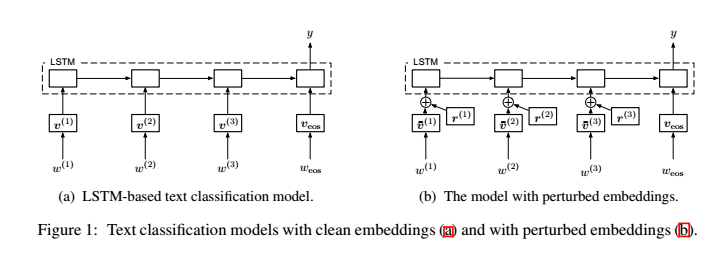最近阅读了有关文本分类的文章,其中有一篇名为《Adversarail Training for Semi-supervised Text Classification》, 其主要思路实在文本训练时增加了一个扰动因子,即在embedding层加入一个小的扰动,发现训练的结果比不加要好很多。
模型的网络结构如下图:

下面就介绍一下这个对抗因子r的生成过程:
在进入lstm网络前先进行从w到v的计算,即将wordembedding 归一化:

然后定义模型的损失函数,令输入为x,参数为θ,Radv为对抗训练因子,损失函数为:

其中一个细节,虽然θˆ 是θ的复制,但是它是计算扰动的过程,不会参与到计算梯度的反向传播算法中。
然后就是求扰动:
扫描二维码关注公众号,回复:
5737627 查看本文章



先对表达式求导得到倒数g,然后对倒数g进行l2正则化的线性变换。
至此扰动则计算完成然后加入之前的wordembedding中参与模型训练。
下面则是模型的代码部分:
#构建adversarailLSTM模型
class AdversarailLSTM(object):
def __init__(self, config, wordEmbedding, indexFreqs):
#定义输入
self.inputX = tf.placeholder(tf.int32, [None, config.sequenceLength], name="inputX")
self.inputY = tf.placeholder(tf.float32, [None, 1], name="inputY")
self.dropoutKeepProb = tf.placeholder(tf.float32, name="dropoutKeepProb")
#根据词频计算权重
indexFreqs[0], indexFreqs[1] = 20000, 10000
weights = tf.cast(tf.reshape(indexFreqs / tf.reduce_sum(indexFreqs), [1, len(indexFreqs)]), dtype=tf.float32)
#词嵌入层
with tf.name_scope("wordEmbedding"):
#利用预训练的词向量初始化词嵌入矩阵
normWordEmbedding = self._normalize(tf.cast(wordEmbedding, dtype=tf.float32, name="word2vec"), weights)
#self.W = tf.Variable(tf.cast(wordEmbedding, dtype=tf.float32, name="word2vec"), name="W")
self.embeddedWords = tf.nn.embedding_lookup(normWordEmbedding, self.inputX)
#计算二元交叉熵损失
with tf.name_scope("loss"):
with tf.variable_scope("Bi-LSTM", reuse=None):
self.predictions = self._Bi_LSTMAttention(self.embeddedWords)
self.binaryPreds = tf.cast(tf.greater_equal(self.predictions, 0.5), tf.float32, name="binaryPreds")
losses = tf.nn.sigmoid_cross_entropy_with_logits(logits=self.predictions, labels=self.inputY)
loss = tf.reduce_mean(losses)
with tf.name_scope("perturloss"):
with tf.variable_scope("Bi-LSTM", reuse=True):
perturWordEmbedding = self._addPerturbation(self.embeddedWords, loss)
print("perturbSize:{}".format(perturWordEmbedding))
perturPredictions = self._Bi_LSTMAttention(perturWordEmbedding)
perturLosses = tf.nn.sigmoid_cross_entropy_with_logits(logits=perturPredictions, labels=self.inputY)
perturLoss = tf.reduce_mean(perturLosses)
self.loss = loss + perturLoss
def _Bi_LSTMAttention(self, embeddedWords):
#定义两层双向LSTM的模型结构
with tf.name_scope("Bi-LSTM"):
fwHiddenLayers = []
bwHiddenLayers = []
for idx, hiddenSize in enumerate(config.model.hiddenSizes):
with tf.name_scope("Bi-LSTM" + str(idx)):
#定义前向网络结构
lstmFwCell = tf.nn.rnn_cell.DropoutWrapper(tf.nn.rnn_cell.LSTMCell(num_units=hiddenSize, state_is_tuple=True),
output_keep_prob=self.dropoutKeepProb)
#定义反向网络结构
lstmBwCell = tf.nn.rnn_cell.DropoutWrapper(tf.nn.rnn_cell.LSTMCell(num_units=hiddenSize, state_is_tuple=True),
output_keep_prob=self.dropoutKeepProb)
fwHiddenLayers.append(lstmFwCell)
bwHiddenLayers.append(lstmBwCell)
# 实现多层的LSTM结构, state_is_tuple=True,则状态会以元祖的形式组合(h, c),否则列向拼接
fwMultiLstm = tf.nn.rnn_cell.MultiRNNCell(cells=fwHiddenLayers, state_is_tuple=True)
bwMultiLstm = tf.nn.rnn_cell.MultiRNNCell(cells=bwHiddenLayers, state_is_tuple=True)
#采用动态rnn,可以动态地输入序列的长度,若没有输入,则取序列的全长
#outputs是一个元组(output_fw, output_bw), 其中两个元素的维度都是[batch_size, max_time, hidden_size], fw和bw的hiddensize一样
#self.current_state是最终的状态,二元组(state_fw, state_bw), state_fw=[batch_size, s], s是一个元组(h, c)
outputs, self.current_state = tf.nn.bidirectional_dynamic_rnn(fwMultiLstm, bwMultiLstm,
self.embeddedWords, dtype=tf.float32,
scope="bi-lstm" + str(idx))
#在bi-lstm+attention论文中,将前向和后向的输出相加
with tf.name_scope("Attention"):
H = outputs[0] + outputs[1]
#得到attention的输出
output = self.attention(H)
outputSize = config.model.hiddenSizes[-1]
print("outputSize:{}".format(outputSize))
#全连接层的输出
with tf.name_scope("output"):
outputW = tf.get_variable(
"outputW",
shape=[outputSize, 1],
initializer=tf.contrib.layers.xavier_initializer())
outputB = tf.Variable(tf.constant(0.1, shape=[1]), name="outputB")
predictions = tf.nn.xw_plus_b(output, outputW, outputB, name="predictions")
return predictions
def attention(self, H):
"""
利用Attention机制得到句子的向量表示
"""
#获得最后一层lstm神经元的数量
hiddenSize = config.model.hiddenSizes[-1]
#初始化一个权重向量,是可训练的参数
W = tf.Variable(tf.random_normal([hiddenSize], stddev=0.1))
#对bi-lstm的输出用激活函数做非线性转换
M = tf.tanh(H)
#对W和M做矩阵运算,W=[batch_size, time_step, hidden_size], 计算前做维度转换成[batch_size * time_step, hidden_size]
#newM = [batch_size, time_step, 1], 每一个时间步的输出由向量转换成一个数字
newM = tf.matmul(tf.reshape(M, [-1, hiddenSize]), tf.reshape(W, [-1, 1]))
#对newM做维度转换成[batch_size, time_step]
restoreM = tf.reshape(newM, [-1, config.sequenceLength])
#用softmax做归一化处理[batch_size, time_step]
self.alpha = tf.nn.softmax(restoreM)
#利用求得的alpha的值对H进行加权求和,用矩阵运算直接操作
r = tf.matmul(tf.transpose(H, [0, 2, 1]), tf.reshape(self.alpha, [-1, config.sequenceLength, 1]))
#将三维压缩成二维sequeezeR = [batch_size, hissen_size]
sequeezeR = tf.squeeze(r)
sentenceRepren = tf.tanh(sequeezeR)
#对attention的输出可以做dropout处理
output = tf.nn.dropout(sentenceRepren, self.dropoutKeepProb)
return output
def _normalize(self, wordEmbedding, weights):
"""
对word embedding 结合权重做标准化处理
"""
mean = tf.matmul(weights, wordEmbedding)
powWordEmbedding = tf.pow(wordEmbedding -mean, 2.)
var = tf.matmul(weights, powWordEmbedding)
stddev = tf.sqrt(1e-6 + var)
return (wordEmbedding - mean) / stddev
def _addPerturbation(self, embedded, loss):
"""
添加波动到word embedding
"""
grad, =tf.gradients(
loss,
embedded,
aggregation_method=tf.AggregationMethod.EXPERIMENTAL_ACCUMULATE_N)
grad = tf.stop_gradient(grad)
perturb = self._scaleL2(grad, config.model.epsilon)
#print("perturbSize:{}".format(embedded+perturb))
return embedded + perturb
def _scaleL2(self, x, norm_length):
#shape(x) = [batch, num_step, d]
#divide x by max(abs(x)) for a numerically stable L2 norm
#2norm(x) = a * 2norm(x/a)
#scale over the full sequence, dim(1, 2)
alpha = tf.reduce_max(tf.abs(x), (1, 2), keep_dims=True) + 1e-12
l2_norm = alpha * tf.sqrt(tf.reduce_sum(tf.pow(x/alpha, 2), (1, 2), keep_dims=True) + 1e-6)
x_unit = x / l2_norm
return norm_length * x_unit
代码是在双向lstm+attention的基础上增加adversarial training,训练数据为imdb电影评论数据,最后的结果发现确实很快就能达到最优值,但是训练所占的空间比较大(电脑跑了几十步就停止了),每一步的时间也稍微长一点。